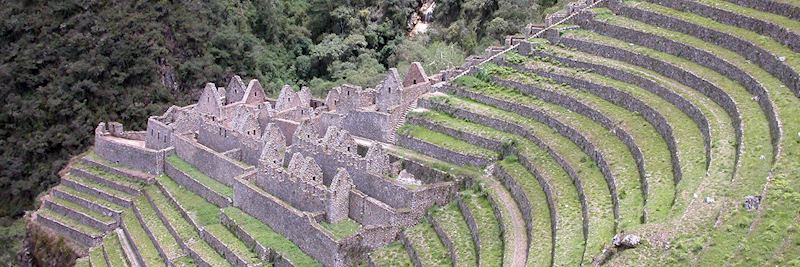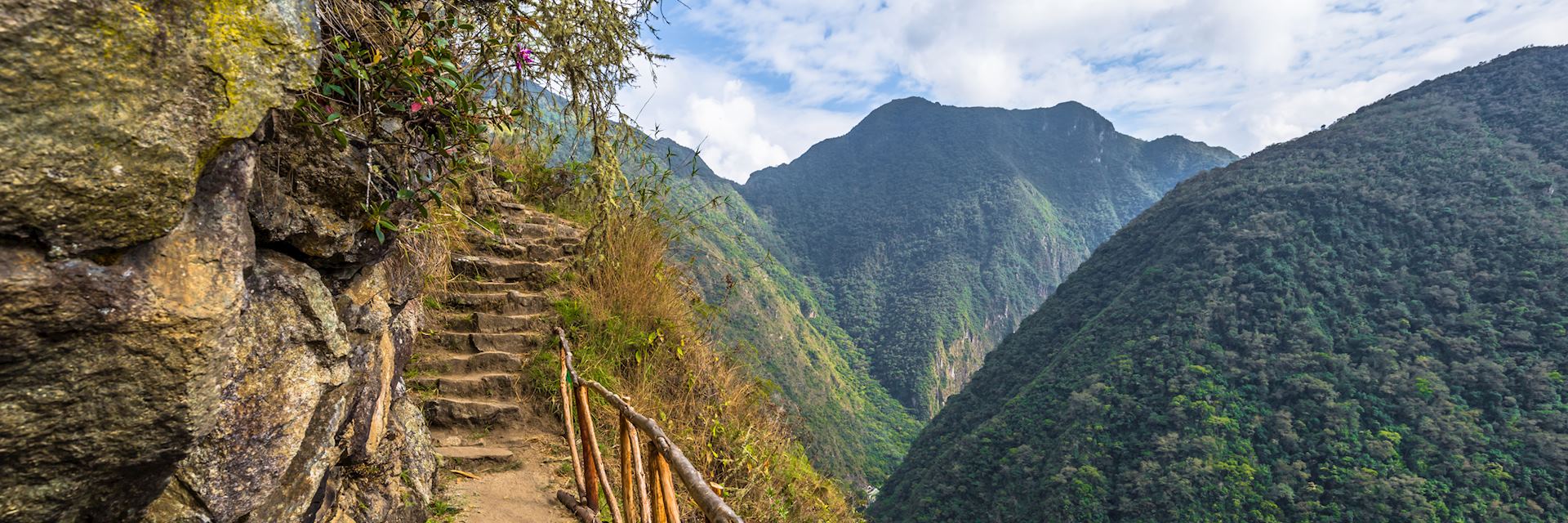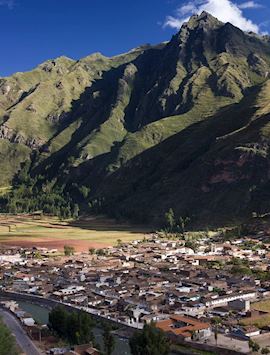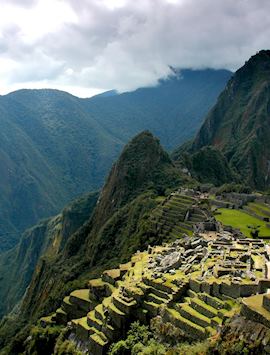By Peru specialist Anna
Why trek to Peru’s Inca mountaintop citadel when you can take the train? Good question. For me, hiking to Machu Picchu is about authenticity as well as a sense of achievement.
If you're walking the Inca Trail or an alternative route, you’ll experience the site's Andean setting so much more intensely. Rather than looking out at the landscape from the ruins, you’ll be part of it, traversing pampas and huge mountain passes. On foot, you approach Machu Picchu as the Incas would have done. You’ll also visit nearby ruins and, on certain treks, meet pre-Hispanic communities. Trekking to Machu Picchu helps you see it in context — not as an isolated relic, but an important part of Quechua culture.
Walk the classic route to Machu Picchu on the Inca Trail

The road to the Inca city is a tortuous path, sometimes dusty, sometimes over Inca-laid paving. It takes you through dense cloudforest, over scrubby mountain passes and across stretches of grassland. Remote Inca fortresses, temples and settlements line the way. Trekkers camp overnight, but porters carry your luggage.
Part of the thrill of this trek is the knowledge that you’re literally treading in the footsteps of a vanished people. The Classic Inca Trail was originally trod by Inca messengers as they brought information from the wider empire to Machu Picchu. The site was closely guarded from the Spanish conquistadors, who never found it.
What to expect on the Inca Trail, day by day

After a pre-trek briefing, the first day begins gently. From the trailhead, you’ll follow the course of the meandering and fast-flowing Urubamba River, then one of its tributaries. Brushing past vegetation such as bromeliads and agave, look out for hummingbirds buzzing between the plants.
En route, the stone terraces and blocky settlements of Patallacta spill down the valley. This Inca site was once used as soldiers’ barracks.
On the second day the going gets tougher. You start in gnarled, lichen-strewn cloudforest where white tailed deer hide out, before the path heads over Dead Woman’s Pass. It’s the trail’s highest point at 4,200 m (13,780 ft).
Rising above the treeline, you’ll chug up flights of rocky steps. Looking out from the pass, which is said to resemble a woman’s prone body, you might glimpse the cloud-scuffed, snow-dusted peaks of Veronica and Salkantay in the distance. In the foreground, mountains rise up at impossibly sheer angles.
The next day, you’ll enter what’s known as the Inca Flat. Walking down Inca staircases and through tunnels cleaved out of granite, you’ll pass more ruins. There’s tiny Qunchamarka, a tambo (an Inca checkpoint or supply point), then Wiñay Wayna, a complex of farming terraces, houses and fountains. This is also where you’ll camp.
Reaching Machu Picchu

The final day begins in the early hours of the morning. Walking among misty forest, there’s a fizz of anticipation in the air.
Most people’s aim is to reach the Intipunku (Sun Gate), once the fortified main entrance to the site, in time to see dawn break over Machu Picchu. In reality, you’re likely to see the fabled endpoint emerging through a veil of mist and cloud. Fear not — it often burns off during the day.
From this perspective, the ruins of Machu Picchu can look almost precariously balanced between mountains. A sinuous white road snakes off down to Aguas Calientes, the village below Machu Picchu, 9 km (5.5 miles) south. Your guide will then lead you on a tour of the site.
Hike the last leg of the Inca Trail in a day on the KM104 Trail
If you’re short on time, or not keen on camping, the KM 104 Trail could be for you. This one-day trek begins by crossing the Urubamba River and clambers uphill via Wiñay Wayna. But you’ll still get your first peek of Machu Picchu through the Sun Gate.
Try the Salkantay Trek, an alternative Inca Trail

Salkantay was the Incas’ most sacred mountain, and it’s still worshipped by local people. This eponymous trek takes you to Machu Picchu via a circuit of towering Andean scenery. It’s a trail of contrasts. You’ll go from austere mountain terrain, passing needle-like peaks, to valleys of orchards and coffee plantations. There are fewer ruins than on the Inca Trail, but the paths are less crowded.
Rather than walk into the site via the Sun Gate, you’ll arrive at Aguas Calientes. You’ll stay the night here before visiting Machu Picchu the next day.
If time and money allow, I’d opt for the longer six-day Salkantay Trek rather than the four-day camping version. The pace is slower, giving you more time to take it all in and get used to the altitude. You’ll also stay in cosy, comfortable mountain lodges — a definite bonus, given how the temperature in the Andes can plummet at night.
The lodges are an experience in themselves. I even zip-lined across a gorge to reach one (although this isn’t compulsory). At the other end of the scale, I spent my penultimate night relaxing in a hot tub, gazing at the Milky Way. Far from any light pollution, the skies were crystal clear.
An overview of the Salkantay Trek

My trek began with a hike to the Humantay Glacier, which feeds into a cyan lake. Others in my group swam. I confess I only dipped a hand in and was astonished at the water’s shattering coldness, despite the hot sun shining down.
Here, by the lake, a local shaman came to greet us. He handed us traditional wool hats and began to conduct a ritual. He mixed herbs, biscuits, beans and confetti in a pouch while chanting to Pachamama (Mother Earth), a goddess to people of the Andes. He then blessed each of us, speaking in Quechua. Our guide interpreted that he was asking the mountain to bring us luck.
After another day of gentle walks to get accustomed to the altitude, our trek began in earnest. We made the crossing from the peaks of Soraypampa to Huayraccmachay, sometimes walking right through the cloud base.
My lodge one night looked out onto the face of Salkantay Mountain, its crest a mass of snow and ice. The most arduous trail section, the ascent to Salkantay Pass, takes you even higher than the Inca Trail. Some 400 m (1,312 ft) higher, to be exact.
The next days consisted of descending through several valleys and pampas. The further we descended, the greener it turned as we left the stony, scrubby mountain paths behind. We passed through cloudforest heavy with orchids, under trees laden with passion fruit, and skirted avocado and banana plantations. You can often hear the gush of a nearby waterfall, or the roar of the Urubamba River.

The final push is an uphill hike in Llactapata Pass. Here, you’ll get a rarely seen view of Machu Picchu in the distance, before descending to the train station.
On this final leg, as we walked across a bridge to reach the station, my gaze was temporarily distracted by a bright flash of red. It was a cock-of-the-rock, Peru’s national (and rare) bird, hopping a stone’s throw away from us.
Get an insight into local customs and communities
An unexpected pleasure on the Salkantay Trek came from the chance to experience different aspects of local culture.
For example, at one lodge we sat down to a traditional Andean barbecue. All sorts of vegetables, tubers and bananas were cooked along with various meats, including guinea pig (a staple local food), over a pile of hot stones and charcoal.
Our trek took us past tiny settlements, villages and farming communities. A highlight was visiting a local coffee plantation, trying our hand at grinding and roasting the beans.
Experience local culture on the Lares Trek

If the cultural aspect of the Salkantay Trek appeals, consider another alternative route to the Inca Trail.
The Lares route takes you through the valley of the same name and involves camping or staying in mountain lodges. As part of the trek, you’ll pass glacier-fed lakes, and visit alpaca farmers and communities of weavers.
Dressed in their customary, vibrant textiles, these local people’s trade and lifestyle have hardly changed for hundreds of years. Although the scenery is slightly flatter and less mountainous, this trek is a chance to see first-hand how everyday Andean people live and work.
Discover Machu Picchu’s ruins through shorter hikes
At 2,430 m (7,972 ft) above sea level, the citadel sits hidden on a high (Inca-levelled) plateau, wedged between two jungle-clad peaks. It’s a city of dry stone walls and granite temples, tombs, lodgings, palaces, watchtowers and astronomically aligned stones arranged over terraces. It’s surrounded on all sides by vertiginous drops and a mountainscape.

Its highlights include the Intihuatana Stone, whose shadow disappears at the equinox, royal tombs where skeletons were unearthed, and the remains of an aqueduct system.
Machu Picchu is thought to have been an emperor’s retreat, or a sacred site designed with cosmology in mind. (Or both — the Incas didn’t distinguish between the profane and the sacred.) In total, the citadel’s area covers 13 sq km (just over 5 sq miles).
Short walks from Machu Picchu
Although you can simply wander around the central ruins, try visiting the site over two days. This will give you time to explore it in more depth through a number of shorter hikes, which you can do even as a day visitor.
Summit Huayna Picchu
The one and a half hour round climb to the top of this pointed cerro (peak) shadowing the ruins to the north is steep. Very steep. You’re also exposed, and the path is slender.
You begin by crawling through a tunnel, and then start the abrupt ascent. It’s a bit like driving along a narrow lane — if you meet someone coming the other way, it requires some careful and considerate choreography. You’re rewarded from the top, however, with a bird’s-eye view of the whole of Machu Picchu.
Walk to the Sun Gate

If you haven’t passed through the gate on a trail, you can also hike to it as a visitor. It takes about an hour there and back, walking on a ledge of jaggedy paving (wear solid footwear).
You can look back and see Machu Picchu framed between the gate’s stone buttresses, seeing it as the original Inca visitors first did when they entered.
Visit the Inca Bridge
The path is short (20 minutes one way). It starts in shaded forest but soon tapers, hugging cliffs with precipitous drops to one side. It’s a hairy experience requiring sure-footedness and a head for heights.
At the end of the trail, you’ll look past a gate to the bridge itself. It’s an impossibly thin strip of stones, clinging to the cliffs and crossing a gorge.
Climb Machu Picchu Mountain

This is, for me, the best walk at the site. I first climbed it after finishing the Salkantay Trek. It’s a longer ascent than Huayna Picchu, but less steep. You’re walking over well-worn rocks and up uneven, deep-treaded steps.
The view from the top is an incredible 360-degree panorama over Machu Picchu and the mountain ranges encircling it. To my delight, glacier-capped Salkantay, where I’d stood mere days ago, was visible.
A note on booking
Places on the Inca Trail, for both the multi-day and the one-day hike, are tightly regulated and sell out quickly: book at least nine months in advance.
If you’re interested in climbing Huayna Picchu or Machu Picchu Mountain, you’ll also need to acquire additional permits in advance of your trip.
Start planning your walking trip to Machu Picchu
Start thinking about your experience. These itineraries are simply suggestions for how you could enjoy some of the same experiences as our specialists. They’re just for inspiration, because your trip will be created around your particular tastes.
View All Tours in Peru




